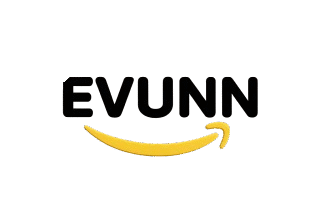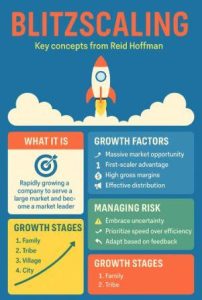Blitzscaling Book Summary

If your first version doesn’t make you cringe, you waited too long to launch. Get it out, get feedback, and get better—fast
The Blitzscaling Book Summary
You’ve got the idea. The drive. The vision.
But now you’re asking: “How the do I scale this thing—fast—without breaking everything?”
You’re not alone. Most startups never make it past “just surviving.”
But the ones that do? They think—and grow—differently.
That’s what Blitzscaling is all about.
Reid Hoffman (yes, the guy behind LinkedIn) spills the exact strategies used by companies like Airbnb, Amazon, and Facebook to grow at lightning speed—even when it looked chaotic.
This book doesn’t sugarcoat it. It shows you when to break the rules of business, how to prioritize speed over perfection, and why being efficient too early can actually kill your momentum.
If you’re serious about building something that can truly scale, you need this playbook in your hands.
So if you’re building something bold, read this Blitzscaling summary—then go grab the book.
It might just change how you scale everything.
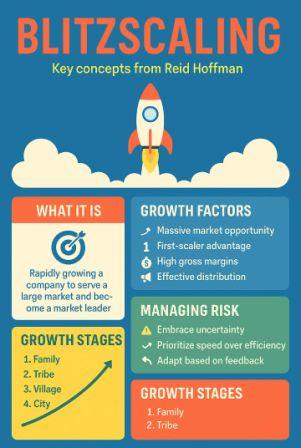
Why We Recommend this Book
Blitzscaling is perfect for people who are scaling a startup, managing rapid growth, or trying to dominate a new market.
Great for anyone facing competitors with more funding, more users, or faster growth. Founders in Silicon Valley and beyond use Blitzscaling to design their go-to-market and hiring strategies.
YC (Y Combinator) startups reference blitzscaling as a guiding philosophy when aiming for aggressive growth.
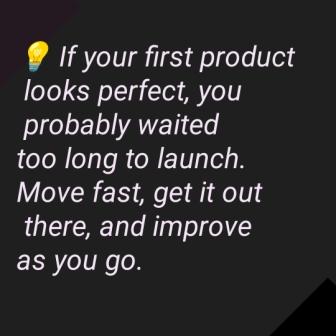
Questions to Ask Yourself before Reading Blitzscaling
- Am I building something that could grow extremely fast? Does my idea/product solve a problem that millions (or even billions) of people have?
- Am I willing to sacrifice efficiency for speed—at least temporarily? How comfortable am I with uncertainty and messiness in business?
- Do I understand the stage my company (or idea) is currently in?
- Is my product already showing signs of product/market fit?
Are customers returning, referring others, or engaging consistently with my product?
- Am I in or entering a “winner-takes-most” market?
- Can I access the capital and talent needed to scale rapidly?
Do I have access to funding and a strategy for hiring at scale?
- Do I have a strong enough reason to blitzscale now instead of growing steadily?
What risks am I taking by not scaling faster? Could a competitor capture the market before me? - Am I ready to constantly evolve my role as a founder or leader?
Am I willing to delegate, replace myself in roles, and grow as a leader?
- How will I balance speed with ethical responsibility?
What core values or boundaries will I not compromise, even when growing fast?
- What am I hoping to take away from this book?
Do I want to implement blitzscaling or just understand how others used it?
Blitzscaling
Introduction
What if growing your business 10x faster—even with a bit of chaos—was not only possible, but actually necessary to win?
That’s the core idea behind Blitzscaling, a game-changing book by Reid Hoffman (co-founder of LinkedIn) and Chris Yeh.
It’s not your typical business book. It’s a behind-the-scenes guide to how today’s most disruptive companies—Airbnb, Facebook, Amazon, Google—scaled with insane speed, broke the rules, and still came out on top.
Blitzscaling is what happens after product-market fit, when the goal is no longer just survival—it’s domination.
This book answers questions like:
- When should you prioritize speed over efficiency—even if it gets messy?
- How do you structure your team and culture when your headcount doubles every few months?
- What do Airbnb, Dropbox, and WeChat have in common that helped them grow fast—and how can you copy it?
It breaks down business model innovation, strategic decision-making, and leadership transitions at each stage of hyper-growth. You’ll learn what to expect, what to avoid, and how to navigate the chaos with clarity.
Playing it safe won’t help you win in today’s fast-moving world. If you’re serious about building a company that leads, not just survives—this book is your battle-tested growth map.
Whether you’re a founder, startup operator, or team lead—Blitzscaling shows you how to think bigger, move faster, and build smarter.
Don’t just grow. Blitzscale.
Grab the book. Your future unicorn self will thank you.

Click on the Tabs Below to Read Blitzscaling Summary
Blitzscaling is about how to grow a company at lightning speed by prioritizing rapid scale over efficiency, embracing uncertainty, and navigating the unique challenges that come with dominating winner-takes-most markets—while learning to do so responsibly.
Who Should Read Blitzscaling?
Blitzscaling is not for everyone, but it’s incredibly powerful for the right readers. Here’s who it’s best for—and why:
1. Startup Founders in High-Growth Markets
Why: This book gives founders a roadmap to scale fast, especially when:
- The market is moving quickly
- The first to scale has a huge long-term advantage
- There are strong network effects (like marketplaces or platforms)
2. Early Employees at Startups
Why: If you’re employee #5 or #50 at a fast-growing company, this book:
- Prepares you for the chaos of growth
- Helps you anticipate changes in structure, roles, and culture
- Teaches you how to grow with the company, not get left behind
3. Investors and Advisors
Why: Understanding Blitzscaling helps investors:
- Spot which startups are in winner-takes-most markets
- Know when to push founders to scale aggressively
- Recognize the inflection points where risky moves become necessary
4. Corporate Innovators / Intrapreneurs
Why: Large companies trying to stay competitive can use blitzscaling principles to:
- Launch internal ventures with startup-like speed
- Win new markets before disruptors take over
5. Ambitious Students or Future Founders
Why: Even if you’re not building yet, Blitzscaling gives you:
- A mental model for spotting massive business opportunities
- Insight into how legendary companies like LinkedIn, Airbnb, and Google got big—fast
Who Should Not Read It (Yet)
- Lifestyle business owners who don’t want to scale big
- Brick-and-mortar entrepreneurs in slow-moving markets
- People looking for step-by-step startup basics (this is not a beginner’s guide like The Lean Startup)
Bottom Line
Read Blitzscaling if you’re trying to build (or be part of) a company that could dominate a large market—and you’re ready to trade comfort for speed.
Part 1: What Is Blitzscaling?
Imagine you’re building a startup, and you’re doing OK—you have a solid product, some users, maybe even some revenue. Normally, the smart thing to do would be to keep improving your product, hire carefully, and grow steadily, right?
But what if I told you there’s another way—a crazier, riskier way—where you grow insanely fast, even if it means losing money, hiring imperfect people, and dealing with total chaos?
That’s what blitzscaling is all about.
The term“Blitzscaling” comes from “Blitzkrieg” (German for “lightning war”), which was all about fast, aggressive moves to overwhelm the opponent. Blitzscaling is similar—but in business.
It means speed over efficiency in an environment of uncertainty, to achieve massive scale before anyone else.
It’s not just about growing. It’s about growing so fast that you outrun competitors and become the dominant player in your market—before anyone else has the chance
1. Software Is Eating (and Saving) the World
The book opens by explaining how software-based businesses scale differently than traditional businesses.
Example:
If you own a bakery and want to sell 10x more bread, you need 10x more ovens, flour, and bakers.
But if you build an app like Airbnb, adding 10x more users doesn’t cost 10x more. Your code works the same, whether it’s 100 users or 100 million.
That’s why tech companies can grow so fast—and why blitzscaling makes sense especially in software and digital markets.
2. The Types of Scaling
Hoffman explains three types of scaling:
- Classic Scaling – Grow efficiently and sustainably.
- Fast Scaling – Grow rapidly but still responsibly.
- Blitzscaling – Grow recklessly fast to dominate the market.
Think of Uber in the early days. They weren’t trying to be profitable at first. They were just trying to enter every city before Lyft did. They gave out free rides, bonuses, discounts… all to grab market share—fast
3. The Three Basics of Blitzscaling
To understand blitzscaling, you need to understand these three things:
a. It’s About Speed, Not Efficiency
You’re burning money. You’re hiring people before you know if they’re perfect. You’re building fast, not clean.
Why? Because if you’re the first to scale and lock in users, you win the market. Facebook wasn’t the first social network—but it scaled faster than anyone else.
b. It Happens in Uncertainty
You don’t know how things will turn out. You’re not following a script. You’re doing this because no one has done it before, and you’re hoping you’ll figure it out as you go.
c. It’s Meant for Winner-Take-All Markets
Some markets reward speed. If you’re first, you get the network effects, the user base, and the buzz.
Example: Think of Amazon. They lost money for YEARS. But now, they’ve dominated e-commerce because they scaled faster than anyone else.
4. The Five Stages of Blitzscaling
Reid and Chris break startup growth into 5 stages—kind of like leveling up in a video game:
1. Family (1–9 employees)
It’s just you and a few people wearing many hats.
2. Tribe (10–99)
You’re building a team, trying to find your groove.
3. Village (100–999)
You have departments now. Chaos begins to show.
4. City (1,000–9,999)
You need systems, managers, and a solid culture.
5. Nation (10,000+)
You’re a global company. You now have power—and responsibility.
Why is this important?
Because what worked in Stage 1 will break in Stage 3. For example, when Airbnb grew past 100 people, their co-founders couldn’t make every decision. They had to delegate, trust others, and hire leaders.
5. The Three Key Techniques of Blitzscaling
These are the tools you need to blitzscale:
a. Business Model Innovation
Create a model that can grow fast. Think freemium apps, platforms, and marketplaces.
Example:
Dropbox gave away storage for free to get people hooked—then upsold paid plans later.
b. Strategy Innovation
You must be willing to pivot fast, take big risks, and choose speed over perfection.
Example:
LinkedIn skipped polishing features early on. They launched with a simple “connect” feature just to get users in. The rest came later.
c. Management Innovation
You need to run a growing team while everything is on fire. You may hire people before you have roles figured out. You manage the chaos—not eliminate it.
Example:
At PayPal, they had a saying: “Let the fires burn.” Meaning—don’t stop and fix every problem. Focus on what matters most.
Blitzscaling is like driving a car 120 mph while building the engine at the same time. It’s messy, scary, and risky—but if you make it, you might end up with a billion-dollar company before your competitors even leave the driveway.
It’s not for every business, but in markets where the winner takes most—speed is your secret weapon.
Part 2: Business Model Innovation
(How to design your business to grow like wildfire)
The next big question is:
“What kind of business model even allows you to grow that fast?”
It’s not every business that can blitzscale. A hair salon? Probably not. A software company? Yes!.
Designing to Maximize Growth: The Four Growth Factors
There are 4 things that make a business model great for blitzscaling. Think of them as growth fuel.
a. Market Size
You can’t blitzscale into a small pond. You need a huge market—millions (or billions) of potential users.
Example:
Airbnb didn’t stop at vacation rentals. They were aiming at the entire global travel industry—worth trillions. That’s blitzscale fuel.
b. Distribution
You need a fast, scalable way to get your product into people’s hands.
Example:
Facebook used virality—users inviting other users.
Dropbox gave you more free storage for referring friends.
This is called distribution leverage
c. High Gross Margins
You want to make a lot of money per sale, with low costs. This lets you reinvest in growth.
Example:
Google makes billions with minimal costs once the search engine is built. Each extra search costs basically nothing.
d. Network Effects
This is the golden ticket. The more users you have, the more valuable the product becomes—for everyone.
Example:
Uber becomes better when more drivers and riders join.
WhatsApp is only useful when your friends are on it.
That makes it hard for new competitors to catch up. It’s like a snowball rolling downhill.
2. Designing to Maximize Growth: The Two Growth Limiters
Here are things that will break your growth. Reid calls these the “drag.”
a. Lack of Product/Market Fit
If people don’t need or want your product badly, blitzscaling will just crash you faster.
Lesson: Don’t blitzscale a half-baked product. Get people begging for it first.
b. Operational Scalability
Can your team handle growth? Can your servers? Can customer service handle 10x more users?
If not, you’ll collapse under your own success.
Proven Business Model Patterns
Now, here’s where it gets juicy. Reid and Chris list business models that work especially well for blitzscaling:
a. Bits, Not Atoms
If your product lives in the digital world, it’s easier to scale.
Example:
Spotify can give 1 song to 100 million users instantly.
But a food delivery startup has to manage drivers, kitchens, etc.
b. Platforms
Let other people create value on your system.
Example:
Airbnb doesn’t own homes.
YouTube doesn’t make videos.
They built the platform, and users bring the content.
c. Marketplaces
Connect buyers and sellers. The more users, the better the experience for everyone.
Example:
Uber, eBay, Fiverr.
d. Subscriptions / SaaS
Recurring revenue = predictable growth + customer loyalty.
Example:
Netflix, Zoom, Slack.
4. The Underlying Principles of Business Model Innovation
Reid says you don’t need to Reinvent Everything – Copy models that already work. Just tweak them.
Look for Leverage – Always ask: “How can I grow faster without doing more?”
It’s OK to Start Ugly – Many blitzscalers began with super rough, simple versions of their product and added sophistication later.
Example:
When LinkedIn launched, all you could do was create a profile and connect. That’s it.
Analyzing a Few Billion-Dollar Business Models
The book closes Part 2 with case studies of companies that nailed business model innovation:
Amazon
- Massive market (retail),
- Focused on speed and scale,
- Took huge risks (like Prime and AWS).
- Lost money for years—now a trillion-dollar empire.
Airbnb
- Turned empty homes into hotel rooms.
- Gained trust through ratings and reviews.
- Created a global marketplace without owning a single building.
- Viral distribution (invite friends).
- Network effects = huge moat.
- Grew so fast, no one could catch them.
Quick Takeaway
To blitzscale, you need a business model that loves speed, scales easily, and feeds itself as it grows.
If your model is too expensive, too hard to scale, or doesn’t create network effects—it won’t work for blitzscaling.
PART 3: STRATEGY INNOVATION
This part answers questions like:
When do I start blitzscaling?
When should I stop?
Can I grow big without blitzscaling?
How does strategy change as my company grows?
When Should I Start to Blitzscale?
Let’s say you’ve built something people really want. Customers are begging for it. Growth is happening organically.
This is your green light to consider blitzscaling.
But here’s the rule:
Only blitzscale when the first-scaler advantage matters more than being efficient.
Let’s say:
- You just launched a food delivery app in Lagos.
- There’s no clear market leader yet.
If you move fast, sign restaurants, and grab customers, you could become the go-to brand.
That’s a winner-takes-most market. Perfect blitzscaling territory.
But if you’re building a small business where competition isn’t fierce or the market is fragmented, blitzscaling might just burn your money.
- You blitzscale when:
- You have product-market fit
- You see signs of rapid demand
A market grab is happening and speed will make you the kingpin
Example:
Uber blitzscaled in city after city to dominate ride-hailing before local competitors could catch up.
When Should I Stop Blitzscaling?
This is a major pitfall—companies often don’t know when to slow down. They burn through money thinking growth = success.
But the truth is:
Blitzscaling is a phase, not a forever strategy.
You stop when:
- Growth slows and you’re now a market leader
- You need to shift focus to profitability
- Scaling any faster will cause internal chaos (bad culture, terrible customer service, etc.)
Example:
Once Facebook dominated social networking, it stopped chasing users like crazy and focused more on monetization (ads, Instagram, etc.).
Can I Choose Not to Blitzscale?
Yes. In fact, many great businesses don’t.
You don’t have to blitzscale to succeed. It’s risky, messy, and capital-intensive.
If you’re a solo founder building a profitable niche SaaS product, you might never need to blitzscale—and that’s fine.
But if you want to build a unicorn and dominate a massive market, blitzscaling is often the only path to beating other well-funded startups.
Blitzscaling Is Iterative
You don’t just go from 0 to 100. You go in loops:
- You blitzscale, then pause to stabilize.
- You build infrastructure to support the new size.
- Then you blitzscale again.
It’s Like:
Grow → Fix what’s breaking → Grow more → Fix again.
Think of it like a slingshot. You keep pulling, releasing, adjusting.
How Blitzscaling Strategy Changes in Each Stage
Remember the stages:
Family → Tribe → Village → City → Nation
Each stage needs a different playbook.
Family (1–10 people)
Focus: Product-market fit
Strategy: Talk to users. Iterate fast.
Tribe (10–100)
Focus: Repeatable customer acquisition
Strategy: Build scrappy growth engines
Village (100–1,000)
Focus: Scale operations
Strategy: Start building departments, hiring managers
City (1,000–10,000)
Focus: Efficiency + control
Strategy: Add structure—finance, HR, legal
Nation (10,000+)
Focus: Global dominance + staying agile
Strategy: M&A, multiple product lines, maintaining innovation at scale
How the Role of the Founder Changes in Each Stage
This is one of the most human and relatable parts of the book.
The job you start with is NOT the job you keep.
At first:
You’re the builder, seller, customer support—everything.
As you scale:
- You hire managers.
- You let go of control.
- Your job becomes vision, culture, recruiting top execs, and removing roadblocks.
Reid Hoffman says:
If you don’t fire yourself from jobs you used to do, your company will outgrow you.
Many founders struggle here. Ego gets in the way. But the best ones evolve or step aside.
Example:
Google’s Larry and Sergey brought in Eric Schmidt to be CEO. They knew they needed experience to scale—and it worked.
Quick Takeaways:
- Start blitzscaling only when it gives you a strategic edge—like grabbing a market before competitors do.
- Stop blitzscaling once you’ve captured your position—then stabilize and make the business sustainable.
- You can grow without blitzscaling—especially in niche or less competitive markets.
- Adjust your strategy and your role at every stage of growth. Blitzscaling is not one-size-fits-all.
- Let go to grow. If you want to lead a blitzscaler, your role must evolve as fast as your company.
PART 4: MANAGEMENT INNOVATION
How to manage a company that’s growing faster than you can handle.
Blitzscaling creates chaos — the kind of growth that breaks systems, people, and even founders. So how do you manage something that’s moving that fast?
Eight Key Transitions in Blitzscaling
Every time your company grows, the rules change. These are 8 major transitions every blitzscaler must go through — and they’re hard.
Transition #1: From small teams to large teams
Before: Everyone knows everything.
After: You need managers and communication systems.
Imagine 10 people in a room vs 200 across continents.
Slack isn’t enough anymore—you need real organisational charts, processes, and strategy.
Transition #2: From generalists to specialists
Before: Everyone wears many hats.
After: You need experts in sales, data, legal, etc.
That marketing guy who also did customer service? Yeah, he can’t manage global ad budgets now.
Transition #3: From single focus to multi-threading
Now you’re juggling product, hiring, partnerships, PR, fundraising — all at once.
Transition #4: From pirates to navy
Startups are pirates.
They move fast, break rules.
But to scale, you need discipline, structure, and long-term thinking.
Facebook had to go from “Move fast and break things” to “Move fast with stable infrastructure.”
Transition #5: From flat structure to hierarchy
As you grow, people need clear reporting lines. Otherwise: confusion, frustration, burnout.
Transition #6: From improvisation to planning
You can’t wing it forever. Eventually, you need budgets, forecasts, KPIs.
Transition #7: From individual contributors to people managers
Founders stop doing tasks and start building teams that build the business.
Transition #8: From founder to CEO (or stepping aside)
Some founders evolve into world-class CEOs. Others realize the company has outgrown them — and that’s okay.
Nine Counterintuitive Rules of Blitzscaling
Here are the crazy things blitzscalers do that go against traditional management wisdom:
Traditional businesses : Wait until you have the right people
Blitzscaler: Hire ahead of need
If you wait until you’re overwhelmed, it’s too late. Blitzscalers hire people for roles that don’t fully exist yet.
Traditional businesses : Focus on efficiency
Blitzscaler: Prioritize speed, even if it’s inefficient
Move fast even if it’s messy. You’ll clean it up later.
Example: PayPal’s fraud system was so manual early on that employees reviewed transactions by hand — but it helped them scale.
Traditional businesses : Perfect the product
Blitzscaler: Launch early and fix later
You need to be in market fast. Even if it’s buggy.
Example: LinkedIn launched with a product Reid Hoffman said was “barely functional” — but they got feedback early and improved fast.
Traditional business : Tries to ensure customers don’t have complaints
Blitzscaler: Knows there would be some angry users and are okay with it if that means growing faster
You’ll make mistakes. Own them, fix them, move on.
The Never-Ending Need for Change
The truth is:
The company you build at 10 people will break at 100.
What worked at 1,000 will fail at 10,000.
So you need a culture of constant reinvention.
You must:
- Kill outdated systems
- Fire yourself from old roles
- Promote fast learners
- Be willing to change what you just built
Example:
Netflix reinvented itself multiple times — from DVD rentals to streaming to original content.
QUICK TAKEAWAYS
- Blitzscaling forces painful management transitions — new systems, roles, and mindsets.
- Success often means breaking traditional business rules and doing things that seem reckless (but strategic).
- You can’t “set it and forget it.” Blitzscaling means constant reinvention.
- Founders must evolve or make space for someone who can — the company’s growth depends on it.
PART 5: The Broader Landscape of Blitzscaling
Blitzscaling Beyond High Tech
Blitzscaling isn’t just for startups making apps or platforms — it’s for any industry where speed is your best weapon.
Example:
Airbnb blitzscaled the travel industry.
WeWork did it with office spaces.
Tesla did it with cars.
Even healthcare startups, like Oscar Health or One Medical, applied blitzscaling to complex systems like insurance and clinics.
The secret is the same blitzscaling pattern:
Grow rapidly → dominate the market → fix the mess later.
So whether it’s food, finance, fashion, or farming, if tech can give you an edge in speed and scale, blitzscaling can apply.
Blitzscaling Within a Larger Organization
Can big companies blitzscale? Yes — but it’s tricky.
Example:
Amazon did it with AWS (Amazon Web Services). Even though it was a big company, they acted like a startup within the organisation. They gave AWS independence, took bold bets, and moved fast.
The key?
- Isolate the team
- Empower them to act quickly
- Protect them from bureaucracy
Think of it as launching a “startup inside a giant.”
Another example:
Microsoft Teams was launched and scaled super fast to beat Slack. It worked because they blitzscaled internally with strong leadership support.
Blitzscaling Beyond Business
What about nonprofits, NGOs, and governments?
Blitzscaling works there too.
Example:
The Obama 2008 campaign.
They used data, tech, and a startup mindset to build the largest grassroots campaign in history — in just 18 months.
Another example:
Khan Academy scaled from one guy making videos to a global education platform with millions of users — all while being a nonprofit.
So blitzscaling isn’t about making money — it’s about solving a big problem fast and at scale.
Blitzscaling in Greater Silicon Valley
Why does so much blitzscaling happen in Silicon Valley?
Three big reasons:
- Access to massive venture capital
- Culture that rewards risk and tolerates failure
- Talent density — engineers, marketers, designers, all in one place
Plus, a mindset that says:
If you’re not growing fast enough to break stuff, you’re not growing fast enough.
That doesn’t mean blitzscaling can only happen there — it just started there.
Other Blitzscaling Regions to Watch
China: The Land of Blitzscaling
The book spends extra time on China — because they’ve mastered hyper-speed growth.
Examples:
Alibaba → E-commerce blitzscaled across China’s rural and urban areas.
DiDi → Beat Uber in China by expanding faster and with local insights.
ByteDance → Creator of TikTok — scaled faster than any social media app in history.
Why does blitzscaling work so well in China?
- Huge population
- Mobile-first economy
- Ruthless competition (if you’re slow, you’re dead)
Defending Against Blitzscaling
If someone’s blitzscaling into your territory, what can you do?
Three strategies:
- Move fast too
Adopt the blitzscaling mindset to stay ahead. - Focus on defensible advantages
Your brand, your customer trust, or regulatory moats — use what can’t be copied easily. - Partner or acquire
If you can’t beat them, buy their speed.
Example: Facebook tried to blitzscale Facebook Live to beat Periscope (Twitter’s product), then acquired Instagram when they saw its potential.
QUICK TAKEAWAYS
Blitzscaling can happen anywhere — tech, nonprofits, even inside big companies.
While Silicon Valley is the original “blitzscaling lab,” other places (especially China) are doing it better and faster.
You don’t have to invent the next Uber — if your industry rewards speed and scale, blitzscaling can work.
If you’re being blitzscaled against, defend smart or join the race.
PART 6: Responsible Blitzscaling
This part asks the big question:
“Just because we can grow at lightning speed… should we?”
So far, the book has been all “go big, go fast” — move fast, dominate the market, fix the mess later.
But Part 6 reminds us that this speed comes with real-world consequences — for people, for society, for the environment. So the question becomes:
How do you scale responsibly without killing your values?
Reid breaks it down this way:
Blitzscaling in Society
Startups often think of customers and profits first, but once you blitzscale, your actions affect:
- Cities (e.g., Airbnb changed housing markets)
- Workers (e.g., Uber changed labor laws)
- Elections (e.g., Facebook changed democracy )
With great scale comes great responsibility.
Example: Facebook blitzscaled its platform — billions of users, no brakes. But it didn’t foresee how fake news, privacy violations, or political manipulation could spiral out of control.
The result? Regulation, public backlash, and trust issues.
So the authors say: You have to think like a systems builder — you’re not just building a company, you’re building part of society.
Framework for Responsible Blitzscaling
The book gives a simple way to think about responsible growth through the Three Levers which are:
1. Do no harm
Avoid actively creating negative outcomes
E.g., Don’t exploit workers or invade privacy
2. Prevent harm
Build in protections proactively
E.g., Add content moderation early, not after the scandal
3. Do good
Go beyond neutral — solve big problems
E.g., Khan Academy or Coursera giving education access globally
Think of these as sliders. You can’t always do all three perfectly, but you should at least acknowledge and balance them as you scale.
The Response Spectrum
How should a company respond when its growth causes problems?
Reid Hoffman and Chris Yeh lay out a spectrum of reactions:
- Ignore (worst)
- Deny
- Minimize
- Acknowledge
- Fix
- Prevent
- Lead (best)
They challenge founders to move as far right on that scale as they can — don’t just react, lead in solving the issues you create or uncover.
Balancing Responsibility and Velocity
Can you really be ethical and still scale fast?
Yes — but it’s a tightrope walk.
Blitzscaling isn’t about being reckless. It’s about making bold bets with eyes open.
The authors recommend:
- Creating “red teams” inside your company to identify risks
- Building diverse teams to avoid blind spots
- Listening to critics (early and often)
- Having values and guardrails before you hit hyperspeed
Example:
Stripe scaled fast and responsibly — they invested early in compliance, user trust, and infrastructure, even when it slowed them down short term. It paid off long term.
You don’t have to choose between doing good and doing well.
Blitzscaling gives you massive power — to change markets, shape culture, and touch millions of lives.
Use that power wisely.
Quick Takeaways:
- Blitzscaling affects more than your company — it impacts the world.
- There’s a framework: Do no harm → Prevent harm → Do good.
- Don’t wait for a crisis — bake responsibility into your strategy from Day 1.
- The best founders are builders and stewards of society.
Here are the things you need to start doing starting from right now to implement the strategies in Blitzscaling:
1. Embrace Uncertainty and Move Fast
“Speed over efficiency” — act before you’re 100% ready.
Step-by-Step:
Step 1: Set a 72-hour decision window for most strategic choices (e.g., launching a new feature, entering a new market).
Step 2: When in doubt, test fast — use MVPs (minimum viable products) to validate.
Step 3: Create a “good enough” checklist instead of waiting for perfection.
Timeframe:
Begin immediately. Apply to all decisions this week.
Challenges:
Perfectionism: Remind yourself that action beats inaction.
Team hesitation: Have a team motto like “Bias for action” to reinforce the mindset.
Metrics:
- Time from idea → decision (track in a Google Sheet)
- Number of MVPs launched per month
- % of decisions made within 72 hours
2. Identify If You’re in a Winner-Takes-Most Market
You only blitzscale if the payoff justifies the risk.
Step-by-Step:
Step 1: Ask: “Does this market reward the biggest player disproportionately?”
E.g., think about Uber vs. a local taxi app.
Step 2: Analyze these three factors:
- Network effects (Does value increase as more people join?)
- Market size (Can it support a $1B+ company?)
- Scalability (Can operations grow fast with lower costs?)
Timeframe:
Spend 1–2 days researching your industry using tools like Google Trends, CB Insights (market intelligence platform), and competitor reviews.
Challenges:
Lack of data: Use proxies like competitor growth or social chatter.
Overconfidence bias: Ask a mentor to challenge your assumptions.
Metrics:
- Complete a Blitzscaling Market Readiness Scorecard (1–10 on each factor)
- Identify 3 competitors and compare their network effect strength
Focus on One Powerful Growth Factor
Instead of trying to improve everything at once (like better marketing, better tech, better customer service, etc.), you should identify the one growth factor that can drive the biggest results for your company—and go all in on that.
Pick your core engine or growth factor from any of these according to what works in your business:
Market Size – Are you playing in a big enough market?
Distribution – Can you reach users fast and cost-effectively?
High Gross Margins – Does your business make enough profit per sale?
Network Effects – Does your product become more valuable as more people use it?
So why focus on just one?
Because when you’re scaling fast (blitzscaling), you don’t have the luxury of perfecting everything. You have limited time, energy, and capital. Doubling down on the most powerful growth lever gives you maximum impact in minimum time.
Facebook focused on network effects. The more people who joined, the more valuable it became—and the faster it grew.
Airbnb focused on market size and distribution. It tapped into an enormous global need (alternative travel stays) and used referrals and trust systems to spread fast.
Step-by-Step:
step 1: To pick your growth factor. Look at your business and ask: What is the one factor that, if optimized, will help us grow 10x faster?
Step 2: Pick your dominant growth factor driver (e.g., viral growth or paid channels).
Step 2: Double down — allocate 70%+ of your growth budget and effort to this channel or driver.
Step 3: Design systems to accelerate it (e.g., referrals, incentives, or automation).
Timeframe:
Choose your key growth factor this week. Test tactics within 14 days.
Challenges:
Spreading too thin: Say no to non-core channels
Slow early traction: Focus on tweaks and rapid iteration.
Metrics:
- Growth from your chosen channel (e.g., daily active users from referrals)
- Customer acquisition cost (CAC) from your top channel
- % of total growth spend allocated to one channel
4. Build a Team for Each Stage of Growth
What works at 10 people breaks at 100 — plan your org like a product.
Step-by-Step:
Step 1: Identify your company’s current blitzscaling stage:
→ Family (1–10), Tribe (10–100), Village (100–1,000), City, Nation.
Step 2: Design roles and culture-fit criteria for your next stage.
Step 3: Start replacing generalists with specialists before chaos hits.
Timeframe:
2–4 weeks for assessment and restructuring plans
Challenges:
Letting go of early hires: Be honest about skill ceilings.
Team resistance: Communicate the “why” clearly and often.
Metrics:
- % of leadership roles filled with scale-appropriate experience
- Turnover or role shifts in the past quarter
- Organizational score from anonymous team feedback
5. Make Counter-intuitive Decisions When Scaling
Sometimes what seems “bad” short-term is best for long-term scale.
Step-by-Step:
Step 1: Identify 1–2 “inefficient” moves you’ve avoided example:
- Delayed hiring until you had steady revenue
- Refused to expand into new markets without full data
- Held off on raising more capital because it felt too soon
Challenge Your Risk Tolerance
By identifying where you’ve played it safe, you can ask:
- “What if I made that risky hire now—would it unlock growth?”
- “What’s the cost of waiting until we’re ‘ready’?”
- “If we don’t act fast, will a competitor beat us to it?
Uber launched in city after city before fully figuring out regulations or profitability.
Was that inefficient? Absolutely.
Did it help them dominate globally? 100%.
That’s blitzscaling.
Step 2: Analyze the upside of these moves if they worked.
Step 3: Create a test plan with guardrails:
“We’ll hire a senior head of growth now with a 90-day ROI target.”
Timeframe:
Choose 1 counter-intuitive move in the next 30 days.
Challenges:
Investor or team pushback: Use scenarios to explain risk vs. reward to investors.
Fear of failure: Make your bet small, but bold. Make your bet small enough that failure won’t destroy you…but bold enough that it can lead to real, meaningful growth if it works.
You may test a bold idea, like launching in a risky market, trying a new pricing model, or targeting a new user segment…but you do it on a limited scale, like:
- One city instead of ten
- $1,000 in ad spend instead of $50,000
This way, you’re not making a “safe” bet, but you’re also not betting the entire company. You’re placing a calculated risk with potential for high reward.
Metrics:
- ROI on your risky investment (e.g., cost of hire vs. new growth)
- Team alignment score (survey after big decision)
- Success rate of “crazy bets” over 6 months
6. Systematize Culture and Decision-Making at Scale
Culture doesn’t scale by accident — it’s your operating system.
Step-by-Step:
Step 1: Document your 3–5 core values with real examples. This step is about defining the soul of your company—the non-negotiable beliefs that guide how your team behaves, makes decisions, and grows.
But it’s not just about writing words like “integrity” or “innovation” on a poster—it’s about bringing them to life through real examples from your team’s behaviour.
When you’re scaling really fast, you’re:
- Hiring dozens (or hundreds) of new people quickly
- Making fast, high-stakes decisions
- Constantly evolving your product or direction
Without a strong culture and clear values, things can get chaotic—and you lose the DNA that made your startup special.
So your core values become your compass.
How to do this:
First: List 3–5 actual values that reflect what your team already believes—not what sounds nice.
(Example: “Move fast,” “Be radically transparent,” “Customer obsession,” etc.)
Second: For each value, write a real story that shows it in action.
Examples:
For “Bias toward action”, you might recall:
“When our app crashed the night before launch, Sarah stayed up all night fixing it without being asked.”
For “Own the outcome”, maybe:
“When we lost a client, our account manager didn’t blame the product—he called the client, took feedback, and created a plan to win them back.”
Third: Share these stories with your team and build them into hiring, on-boarding, and daily work.
Example:
Netflix has a famous culture doc with values like “Freedom & Responsibility.”
They didn’t just say it—they lived it. One example is:
No vacation policy. People took time off whenever they needed—because they trusted their team to deliver results.
Step 2: Build rituals that reinforce your core values. Don’t just say what your company values — show it in your everyday habits.
Create repeatable activities (aka rituals) that make your values part of how your team thinks, behaves, and makes decisions every day.
These rituals could happen during On-boarding (how you welcome new hires), Weekly all-hands (team meetings), Internal communications (like Slack channels, email updates, etc.)
Rituals = culture glue.
They help you:
- Keep everyone aligned
- Build team trust and identity
- Prevent miscommunication and value drift.
Examples of rituals you could create:
Onboarding
Include a session where new hires learn the company’s 3–5 core values, with real stories and examples.
Pair them with a “culture buddy” who models those values in action.
Weekly All-Hands Meetings
Give shoutouts to employees who lived out a core value that week.
E.g., “Shoutout to David for jumping in to help a customer at midnight—true ‘Customer Obsession.’”
Slack Channels
Create a #living-our-values channel where anyone can post examples of team members demonstrating a core value. Create emoji reactions that represent each core value.
Step 3: Set up decision frameworks. This means creating simple rules or principles your team can follow to make decisions faster and more consistently, especially when growing rapidly.
When you’re blitzscaling, you can’t afford analysis paralysis.
You’re:
- Hiring quickly
- Launching fast
- Making daily decisions under uncertainty
A clear decision framework empowers your team to act boldly and quickly—without waiting for perfect data or endless meetings.
You can make decision rules like:
70% confidence → decide
- If you’re 70% confident in a decision, go ahead and do it.
- Don’t wait for 100% certainty — you’ll be too slow.
Example:
Your marketing team thinks a new campaign could double signups. They’ve tested a few headlines, gotten decent results, but the data isn’t perfect.
Instead of stalling for more tests, they go ahead and launch based on 70% confidence.
“Disagree and commit”
It’s okay to disagree in the decision-making process…
But once the decision is made, everyone commits 100% and supports it, no sabotage or grumbling.
Example:
Two co-founders argue over which market to enter first. One strongly prefers Kenya, the other prefers India.
They debate, then choose India.
Even though one founder disagreed, he fully supports the decision and works hard to make it succeed.
One of Amazon’s leadership principle “Disagree and Commit” helps them move fast.
Jeff Bezos once said:
“If you have conviction on a particular direction even though there’s no consensus, it’s helpful to say: ‘Look, I know we disagree on this but will you gamble with me on it? Disagree and commit?’”
It allows speed without endless debate.
Timeframe:
1 month to fully roll out across the team.
Challenges:
Lip service culture: Make sure leadership lives it visibly.
New hires diluting the vibe: Add values-based screening to hiring.
As your company grows fast, you’ll hire a lot of new people. If you’re not careful, they might not share the same beliefs, attitude, or energy that made your team special in the first place.
So, you need to actively screen for culture fit and core values—not just skills.
Hiring someone who’s super smart but doesn’t “get” your company vibe can slowly weaken your team spirit, energy, and culture.
Start by asking things like:
- Will they treat customers like we do?
- Do they believe in speed over perfection, if that’s your value?
- Are they humble team players, or just chasing personal glory?
Metrics:
a. Check the Culture alignment score from on-boarding surveys
b. Number of decisions were made using documented frameworks. As your company grows quickly, more people are making decisions — and if everyone uses their own logic, chaos happens.
c. Carry out Employee NPS (Employee Net Promoter Score) every months. It’s a regular check-in to see how happy your team is — and whether they’d recommend working at your company.
It’s one of the simplest, smartest ways to keep your finger on the pulse of your company’s culture and employee experience.
How is Employee NPS calculated?
It’s the % of Promoters minus % of Detractors.
Example:
- 60% are Promoters
- 20% are Detractors
- 20% are Passives (ignored in scoring)
Employee NPS = 60% – 20% = +40
Why is it measured quarterly?
Blitzscaling = rapid change = high stress.
You want to catch morale dips early, before people burn out or quit.
It gives you regular feedback on how employees are really feeling.
Quarterly is often enough to spot trends, but not so frequent that it becomes annoying.
Why is Employee NPS important in blitzscaling?
During blitzscaling, your team is:
- Growing fast
- Working hard
- Facing chaos
So it’s easy to lose touch with how your people feel. A healthy Employee NPS can signal strong morale and culture. A drop could mean it’s time to fix deeper issues before they lead to high turnover or low performance.
7. Practice Responsible Blitzscaling
Don’t just grow fast — grow wisely.
Step-by-Step:
Step 1: Create a “Red Team” to anticipate ethical, legal, or social risks. This is a a special group inside your company — called a Red Team — whose job is to intentionally challenge your ideas, decisions, or products from a critical perspective.
Their main goal is to spot potential harm (to people, society, or your company) before it happens — especially as you’re growing fast.
Why is this important in blitzscaling?
While you are moving fast, this speed helps you grow, and it can accidentally create big problems too like:
- Privacy violations
- Legal issues
- Social backlash (e.g., Facebook & misinformation)
- Unethical outcomes (e.g., bias in AI)
- Losing user trust
A Red Team acts like your internal critic — asking:
“If this went wrong, how would it look? Who could it hurt? How do we prevent that?”
Facebook grew insanely fast, but they didn’t have a proper Red Team questioning how bad actors could abuse the platform. The result was misinformation,
election interference, privacy scandals.
Now, many tech companies have Red Teams that:
- Simulate what a hacker or regulator might do
- Look for hidden biases in algorithms
- Test if your product could be misused
How to implement a Red Team
First: Recruit the team. Gather a small group (3–5 people) from different departments — legal, product, ethics, security, even an outsider if possible.
Make sure they’re independent thinkers who can speak freely.
Second: Define the mission. Their job is to challenge ideas before launch: policies, features, campaigns, or growth tactics. They They ask hard questions like: “What’s the worst-case scenario?”
Third: Schedule Red Team reviews. Before big decisions or launches, the Red Team runs a “what could go wrong” workshop.
They write a short Risk Brief: what could go wrong and what safeguards are needed.
Four: Empower them. Their findings should influence leadership — not be ignored. Create a rule: “No launch without Red Team sign-off.”
Step 2: Add a checklist for product launches:
“Who could this harm?” “Are there unintended consequences?”
Step 3: Publish a one-pager on your company’s social responsibility stance.
Timeframe:
45–60 days to set up systems and review first product risk
Challenges:
It feels like it slows growth: Remind the team that bad press or lawsuits slow it more.
No expertise: Involve advisers, legal, or ethics professionals.
Metrics:
Check the number of product launches with risk review
% of employees who can name your responsibility principles
Check your External reputation score (brand sentiment tracking)
Quick Takeaways:
Start small. Pick 1 or 2 actions this week. Build momentum.
And remember: Blitzscaling is a mindset — fast, smart, and increasingly human.
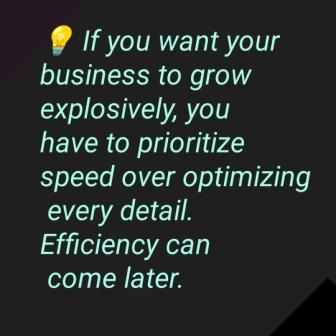
Reid Hoffman
Reid Hoffman is a legendary entrepreneur and venture capitalist best known as the co-founder of LinkedIn.
He’s also a partner at Greylock Partners, where he has invested in game-changing startups like Airbnb and Facebook. With a deep understanding of what makes companies grow and dominate, Hoffman shares insights based on firsthand experience from Silicon Valley’s frontlines.
He’s also a co-author of the bestselling book The Startup of You and host of the popular podcast Masters of Scale.
Chris Yeh
Chris Yeh is an entrepreneur, writer, and startup mentor who has worked with hundreds of high-growth companies over two decades. He holds degrees from both Stanford University and Harvard Business School and is known for his practical frameworks on scaling businesses, leadership, and startup culture.
Chris co-authored The Alliance with Reid Hoffman and Ben Casnocha.
Book Details
Title: Blitzscaling: The Lightning-Fast Path to Building Massively Valuable Companies
Authors: Reid Hoffman and Chris Yeh
Publisher: Currency (an imprint of Crown Publishing Group, part of Penguin Random House)
Publication Date: October 9, 2018
Genre: Business, Entrepreneurship, Startup Strategy
Formats Available: Hardcover, Paperback, eBook, Audiobook
Page Count: 336 pages
ISBN-13: 9781524761417
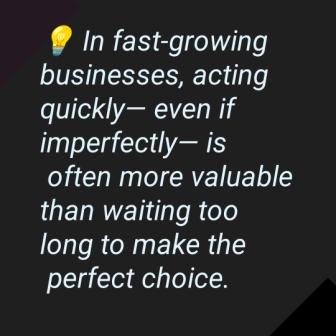
Blitzscaling Quiz
-
Start Blitzscaling Quiz
